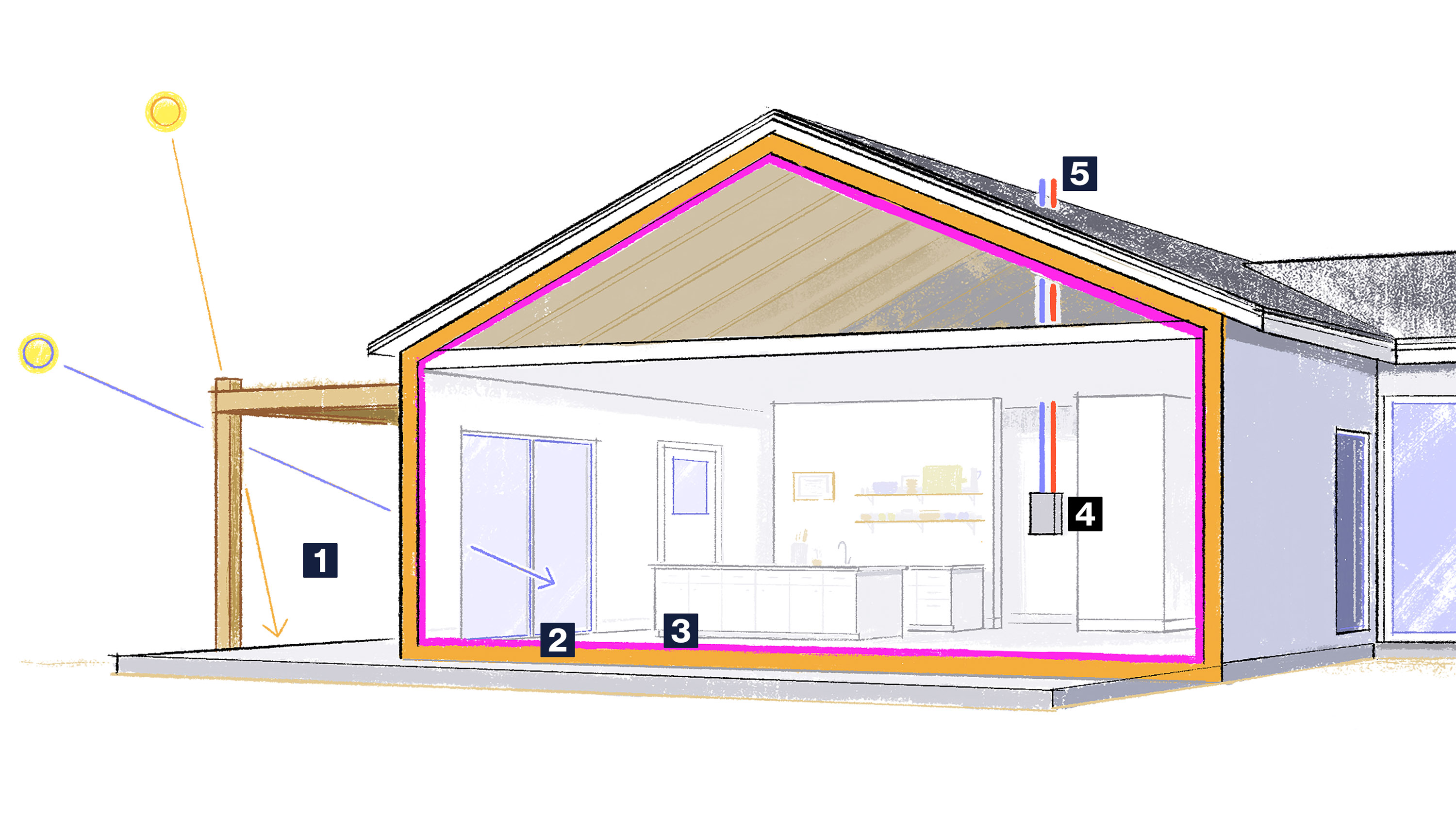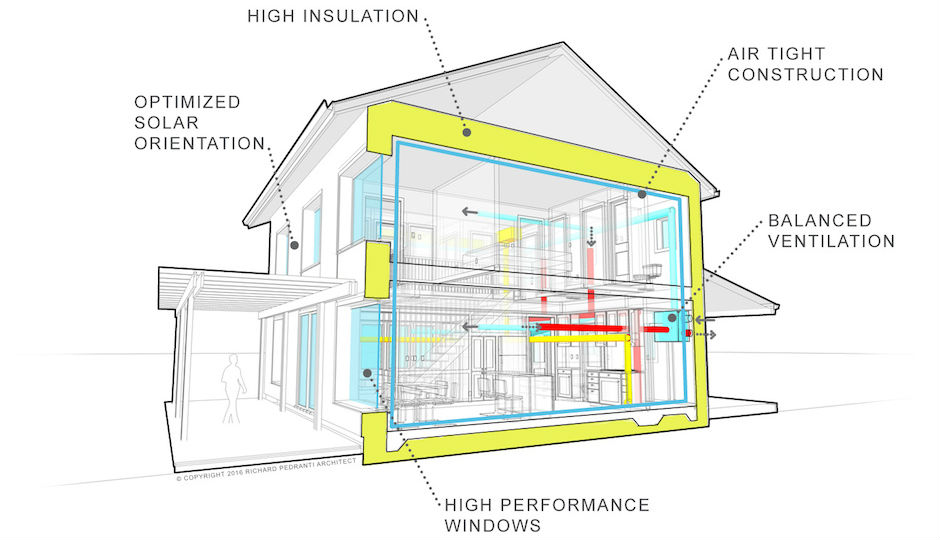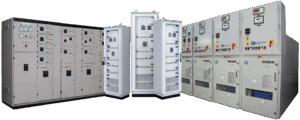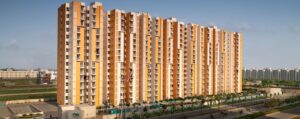Modern insulation technologies reduce Emigrant Pass home energy consumption by 40-60% compared to homes with outdated insulation systems. The region’s extreme temperature variations—from below-freezing winters to 90°F+ summers—make high-performance insulation particularly effective, with spray foam applications delivering R-values of 6-7 per inch versus traditional fiberglass batting’s 2.2-2.7 per inch. According to the Nevada Energy Commission’s 2024 residential efficiency study, properly insulated Emigrant Pass homes maintain stable indoor temperatures with 43% less HVAC runtime.
Emigrant Pass’s unique elevation (over 6,000 feet) creates specific insulation challenges that modern solutions directly address. High-altitude environments experience more intense solar radiation, greater temperature fluctuations, and stronger winds—all factors that compromise traditional insulation performance. Advanced insulation systems create complete thermal envelopes that eliminate air leakage pathways while providing consistent R-value throughout the structure, even in previously difficult-to-insulate areas like rim joists and attic knee walls.

Modern Insulation Technologies for High-Altitude Performance
Insulation Material Comparison for Emigrant Pass Conditions
The following table compares how different insulation materials perform in Emigrant Pass’s specific climate conditions:
| Material | R-Value Per Inch | Air Sealing | Moisture Resistance | Performance in Extreme Temps | Lifespan | Installation Complexity |
|---|---|---|---|---|---|---|
| Spray Foam (Closed Cell) | 6.0-7.0 | Excellent | Excellent | Excellent | 50+ years | Moderate |
| Spray Foam (Open Cell) | 3.5-3.8 | Excellent | Good | Good | 50+ years | Moderate |
| Fiberglass Batts | 2.2-2.7 | Poor | Poor | Poor | 15-20 years | Easy |
| Blown Cellulose | 3.2-3.8 | Good | Good | Good | 20-30 years | Easy |
| Mineral Wool | 3.0-3.3 | Fair | Excellent | Excellent | 30+ years | Moderate |
| Rigid Foam Board | 4.0-6.5 | Good | Good | Good | 20+ years | Moderate |
Technical Specifications for Optimal Energy Performance
Understanding the technical requirements for Emigrant Pass homes helps property owners make informed decisions:
| Performance Metric | Minimum Recommended Value | Premium Performance Value | Impact on Energy Use |
|---|---|---|---|
| Attic R-Value | R-49 | R-60 | 15-20% HVAC reduction |
| Wall R-Value | R-21 | R-28 | 10-15% HVAC reduction |
| Floor R-Value | R-30 | R-38 | 5-10% HVAC reduction |
| Air Changes per Hour (ACH) | 3 ACH | <1 ACH | 20-30% HVAC reduction |
| Window U-Factor | 0.30 | 0.22 | 10-15% HVAC reduction |
| Door U-Factor | 0.28 | 0.20 | 3-5% HVAC reduction |
| Duct Leakage | <10% | <5% | 10-15% HVAC reduction |
Research from the High-Altitude Building Performance Institute shows that properly insulated and air-sealed homes at elevations above 5,000 feet maintain indoor temperature stability with significantly less energy input. Their 2024 study across 200 mountain homes found that those with modern insulation systems used 56% less energy for heating and 38% less for cooling compared to similar homes with conventional insulation.
Climate-Specific Considerations for Emigrant Pass
Emigrant Pass experiences approximately 7,000 heating degree days annually, placing it in the high demand category for insulation performance. The region’s diurnal temperature swings often exceed 40°F, especially during spring and fall, creating significant thermal stress on building envelopes.
Winter wind patterns through the pass accelerate heat loss in poorly insulated structures. Modern insulation addresses this through complete air sealing that eliminates wind washing—the phenomenon where moving air strips away heat from insulation materials. This is particularly important for homes situated on exposed ridgelines or in wind-tunnel valleys common throughout the Emigrant Pass area.
Bonus Tip: For homes in Emigrant Pass’s windier locations, focus extra attention on insulating rim joists and band boards, which often account for up to 15% of a home’s total air leakage. Applying closed-cell spray foam to these areas creates both an air barrier and vapor barrier in locations traditional batting cannot effectively seal.
Key Benefits of Modern Insulation Systems
Energy Consumption Reduction
Modern insulation dramatically cuts energy usage through multiple mechanisms:
- Creates continuous thermal barriers without gaps or compression
- Eliminates thermal bridging through framing members
- Maintains consistent R-value regardless of temperature extremes
- Prevents air movement that bypasses traditional insulation
- Reduces HVAC system sizing requirements and runtime
The Department of Energy’s Building America program documented that high-altitude homes with comprehensive modern insulation packages require 40-60% less energy for space conditioning compared to code-minimum insulated properties.
Enhanced Comfort and Air Quality
Beyond energy savings, modern insulation improves living conditions by:
- Eliminating cold spots and drafts common in partially insulated homes
- Maintaining consistent temperatures across all rooms and levels
- Reducing outdoor noise transmission by 30-50%
- Preventing dust and allergen infiltration through air sealing
- Controlling humidity levels by preventing condensation on cold surfaces
Extended Building Durability
Properly installed modern insulation protects structural elements:
- Prevents moisture accumulation that leads to mold and wood rot
- Reduces thermal expansion/contraction stress on building materials
- Eliminates ice dams that damage roofing and fascia
- Prevents pest and insect infiltration through sealed entry points
- Reduces UV degradation of interior finishes by stabilizing temperatures
Things to Consider Before Making a Decision
When evaluating insulation upgrades for Emigrant Pass homes, several factors warrant careful consideration:
- Home Age and Construction Type: Older log homes and stone structures have different insulation requirements than modern frame construction.
- Current Performance Issues: Identify specific problems (cold rooms, high bills, ice dams) to target solutions effectively.
- Budget Timeline: While premium insulation costs more initially, energy savings typically provide 3-7 year payback periods in high-altitude locations.
- Occupancy Patterns: Vacation homes with periodic occupancy benefit from different insulation strategies than full-time residences.
- Future Renovation Plans: Coordinate insulation upgrades with other planned improvements for cost efficiency.
Comprehensive Insulation Services
Residential Insulation
Complete home envelope solutions engineered specifically for high-altitude performance. Includes detailed thermal imaging analysis to identify existing weak points and custom-designed solutions for Emigrant Pass’s unique climate demands.
Commercial Insulation
Engineered solutions for businesses, warehouses, and municipal buildings that address both thermal performance and code compliance. Includes energy modeling to demonstrate ROI and potential utility incentive qualification.
Attic Blown-in Insulation
Specialized application of high-performance loose-fill materials at appropriate depths for Emigrant Pass’s climate zone. Includes proper ventilation baffles and complete air sealing of penetrations before insulation installation.
Insulation Removal
Safe extraction of outdated, damaged, or contaminated insulation materials. Includes proper disposal and thorough preparation of surfaces for new insulation application.
Thermal Barrier Coatings
Application of specialized coatings that enhance fire resistance and thermal performance while meeting local building codes. These systems provide additional protection in high-wildfire-risk areas.
Agricultural Foam and Coating
Durable solutions for barns, equipment storage, and workshop spaces that withstand rural environmental challenges while improving energy efficiency year-round.
Roof Coatings
Specialized reflective and insulating coatings that reduce heat absorption and prevent UV degradation of roofing systems. These coatings provide particular value in high-altitude environments with intense solar exposure.
Spray Foam Roof Insulation
Direct application of closed-cell foam to roof decking that creates a seamless waterproof and thermal barrier. This system eliminates thermal bridging through roof structures while providing superior insulation values.

Common Questions About Modern Insulation
Understanding key considerations helps homeowners make informed decisions about insulation upgrades:
- How disruptive is the installation process? Modern insulation installation typically takes 1-3 days for an average home, with areas being insulated unavailable during application and curing. Residents should plan to be away during spray foam application and for 24 hours afterward.
- Will modern insulation create moisture or ventilation problems? Properly designed systems include appropriate ventilation strategies. In Emigrant Pass’s dry climate, mechanical ventilation is often recommended alongside air sealing to maintain ideal indoor humidity levels between 30-50%.
- How much energy savings can realistically be expected? Emigrant Pass homes typically see 40-60% reduction in heating costs and 25-40% reduction in cooling costs after comprehensive insulation upgrades, according to regional utility data.
- Is it necessary to insulate the entire home at once? While complete insulation provides optimal performance, phased approaches can work when prioritizing areas with greatest heat loss (typically attics first, followed by walls, then foundations).
Bonus Tip: In Emigrant Pass homes with cathedral ceilings, specify closed-cell spray foam between roof rafters rather than open-cell variants. The higher density material prevents winter condensation issues that frequently develop when warm, moist indoor air contacts cold roof sheathing—a common problem at higher elevations.
Frequently Asked Questions
How does modern insulation perform during Emigrant Pass power outages?
Modern insulation significantly extends the thermal flywheel effect of a home. Properties with comprehensive insulation packages typically maintain habitable temperatures 3-4 times longer during winter power outages compared to conventionally insulated homes. This passive resilience provides critical protection during the region’s occasional winter storms and grid disruptions.
Can existing insulation be upgraded without complete removal?
In some cases, existing insulation can be enhanced rather than replaced. However, simply adding new material over old often traps air leakage pathways and can create condensation planes. Professional assessment determines whether targeted removal and replacement or complete overhaul delivers better performance.
How do modern insulation materials impact indoor air quality?
Today’s high-performance insulation materials undergo strict testing for emissions and off-gassing. After the initial installation period (24-48 hours), modern materials are chemically stable with minimal VOC emissions. The air sealing component actually improves indoor air quality by preventing infiltration of outdoor pollutants and allowing for controlled ventilation.
What maintenance does modern insulation require?
Quality modern insulation systems require minimal maintenance. Annual visual inspection for any settlement, damage from pests, or water intrusion is recommended. Unlike traditional materials that can settle and degrade, spray foam and properly installed modern systems maintain performance for decades without intervention.
Does modern insulation affect home resale value?
High-performance insulation consistently ranks among the top five features home buyers seek in mountain and high-altitude properties, according to the National Association of Realtors’ 2024 Home Features Survey. Properties with documented energy performance typically command 4-6% higher sale prices and sell 24-38% faster than comparable less-efficient homes.
Ready to Achieve Superior Energy Efficiency
Emigrant Pass homes face unique energy challenges that modern insulation solutions directly address. The combination of high altitude, extreme temperature variations, and intense solar exposure creates conditions where premium insulation delivers exceptional returns through both energy savings and improved comfort.
Apply these insights now: Schedule your comprehensive home energy assessment with Nevada Urethane. Experience the difference properly engineered insulation makes in mountain home performance.
Nevada Urethane, (775) 500-0024, [email protected]
Reviewer: Maria Lopez offered detailed feedback after reviewing this post. Her 10 years of experience in spray foam work helped guide the tone and suggestions toward realistic strategies.





